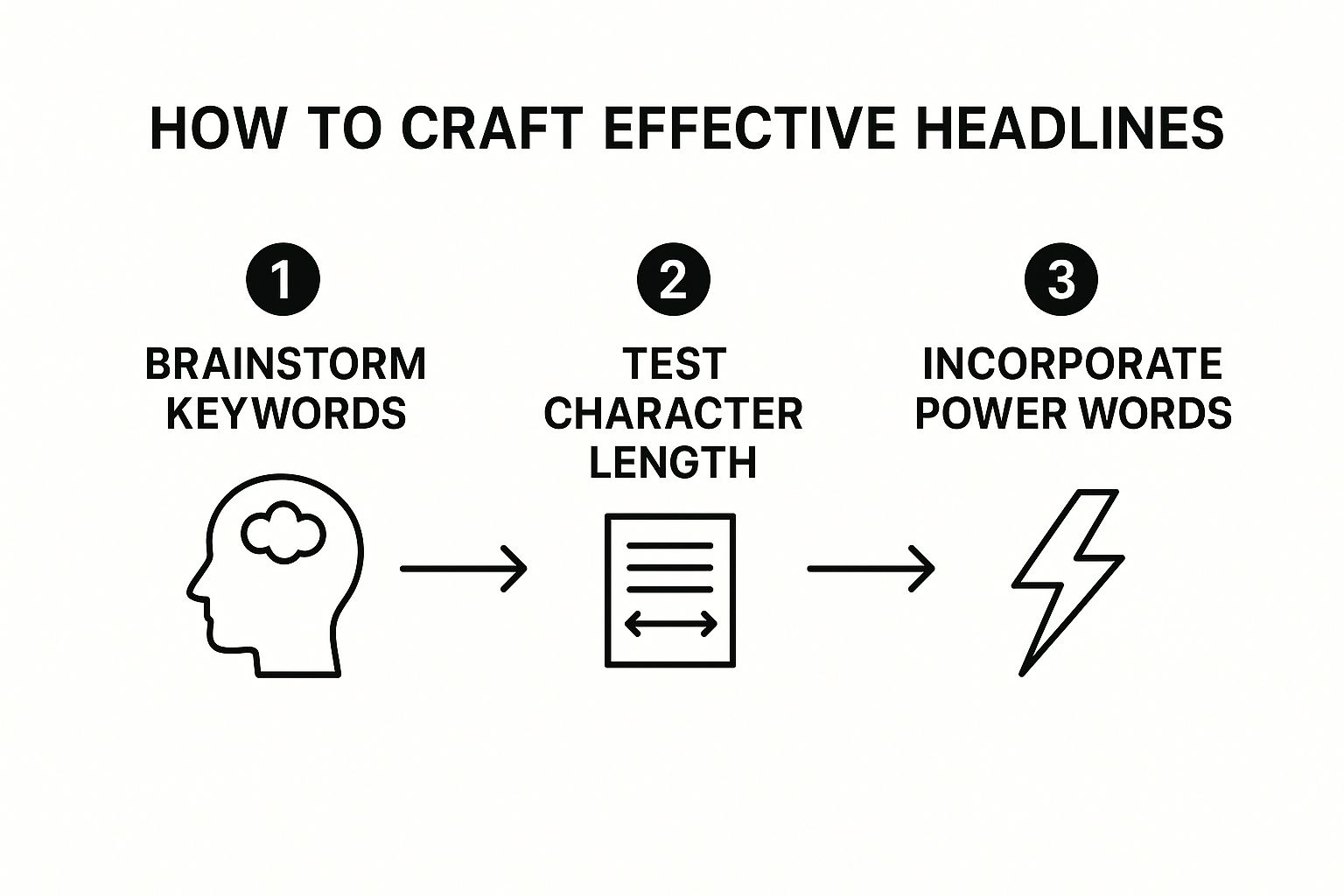If you want to write an SEO article that actually ranks, it all comes down to three things: satisfying search intent, proving your expertise, and creating genuinely in-depth, valuable content. This isn't just about writing; it's a strategic process of figuring out exactly what your audience needs and then delivering the best possible answer in a way search engines can easily digest.
Why Some Articles Rank and Others Don't

Ever pour hours into crafting what felt like the perfect article, only to watch it get buried on page five of Google? It’s a classic, frustrating scenario. The problem usually isn't the writing itself, but a fundamental disconnect between what you wrote and what search engines—and their users—actually value.
The old-school trick of just stuffing keywords into a page is long dead. Today, Google's algorithm is smart enough to reward content that genuinely helps people. Your article needs to be the most definitive, helpful resource for a user's query. This all starts with understanding their motivation.
Mastering Search Intent
Search intent is the "why" behind every search query. Is someone trying to learn something (informational), find a specific website (navigational), or get ready to buy something (transactional)? Your content's angle, format, and depth have to align perfectly with that intent.
For instance, a search for "best running shoes" signals that the user wants a comparison article, likely a list with pros and cons. If you serve them a deep dive into the history of footwear, you’ve completely missed the mark. Misaligning with intent is one of the quickest ways to get your article ignored by Google. The best practice here is to always analyze the top-ranking results for your target keyword to see what's already working.
Proving Your Credibility With E-E-A-T and Content Depth
Beyond just matching intent, Google heavily relies on its E-E-A-T framework (Experience, Expertise, Authoritativeness, and Trustworthiness) to gauge content quality. It's not enough to simply cover a topic anymore; you have to prove you’re a credible source.
This means you need to:
- Share unique insights drawn from your own real-world experience.
- Cite trustworthy sources and data to back up your claims.
- Write in a clear, well-organized, and professional style.
- Build a solid, trustworthy brand reputation over the long haul.
A massive part of demonstrating expertise is content depth. The data doesn't lie: articles that run over 3,000 words tend to pull in three times more traffic than shorter pieces. These comprehensive articles also get four times more social shares and 3.5 times more backlinks—all critical signals for ranking. Why? Because longer, more thorough articles do a much better job of satisfying user curiosity and signaling to search engines that you're an authority. You can dig into more of these kinds of insights on AIOSEO.com.
To pull all these ideas together, here’s a quick-glance table outlining the foundational pillars of a great SEO article.
The Pillars of a High-Ranking SEO Article
| Pillar | Why It Matters for SEO | Quick Tip |
|---|---|---|
| Search Intent Alignment | This is the #1 factor. If you don't answer the user's "why," Google won't show them your content. | Always Google your target keyword and analyze the format of the top 3-5 results. |
| E-E-A-T | Builds trust with both users and search engines, proving your content is reliable and authoritative. | Add an author bio, cite external data, and include unique examples from your own experience. |
| Content Depth | Comprehensive content keeps users on your page longer and provides more value, signaling quality to Google. | Aim for long-form content (3,000+ words) that covers a topic from every possible angle. |
| Readability & UX | If your article is a wall of text, people will leave. Good formatting improves user experience. | Use short paragraphs, headings, bullet points, and images to break up text and make it scannable. |
Think of these pillars as the blueprint for any article destined for page one.
The core principle is simple: An article that ranks isn't just written—it's engineered. It's a carefully constructed piece that aligns perfectly with what users are looking for and proves its credibility at every turn.
In the end, articles that hit the top of the search results are built on a foundation of genuine value. They don’t just skim the surface; they provide the most thorough, trustworthy, and helpful answer out there.
Finding Keywords That Actually Drive Traffic

Before you ever write a single word, the success of your article is already being decided. It all starts with keyword research—getting into the head of your audience and figuring out the exact phrases they’re typing into Google.
This isn’t about just chasing massive search volumes. It’s about finding the terms that show someone is ready to learn something new, solve a problem, or connect with a brand like yours.
A classic mistake is aiming for super broad, competitive keywords. If you just launched a coffee blog, trying to rank for "coffee" is a recipe for disaster. You’re up against giants, and you have no idea what the searcher actually wants. The real magic happens with long-tail keywords.
Uncovering Long-Tail Opportunities
Think of long-tail keywords as full questions or specific phrases. Instead of "cold brew," you'd target something like "how to make cold brew without equipment." The search volume is lower, sure, but the person searching for it is highly motivated and knows exactly what they need.
My go-to tools for digging these up are Ahrefs and Semrush, but you can find gold just by looking at Google's "People Also Ask" box. Start with a broad topic ("content marketing," for instance) and see what questions pop up. You’re essentially looking for problems you can solve with your content.
A quick search might unearth phrases like:
- "Content marketing examples for SaaS"
- "How to measure content marketing ROI"
- "Best B2B content marketing strategies"
Each one of these is a pain point. When you build an article around a specific query like this, you’re not just hoping to rank; you're directly answering a user's question, which is what Google wants. If you want to go deeper on this, check out these keyword research best practices.
Decoding SERP Intent
Once you’ve got a keyword that looks promising, do not skip this next part. You have to analyze the search engine results page (SERP). Seriously, open an incognito window and Google your term.
Look closely at the top 10 results. What are they? Listicles? In-depth guides? Case studies? The SERP is Google showing you its hand. It's telling you, "This is the kind of content that satisfies people searching for this term."
If the entire first page for "best running shoes for beginners" is filled with list-based review articles, writing a long-form history of footwear is a waste of time. Google has already figured out that searchers want a list to compare options. Your job is to create a better, more helpful list than what’s already there.
This SERP analysis also tells you who you’re up against. Are you seeing huge names like Forbes and HubSpot, or are smaller, niche blogs holding the top spots? This helps you pick your battles. For a newer site, targeting keywords where you see other smaller players ranking is a much smarter play.
This strategic approach is what separates content that gets traffic from content that just sits there. And it matters—businesses that maintain an active blog generate a whopping 67% more leads per month than those that don't. While the average SEO article now clocks in at around 1,427 words, very few brands (3%) are consistently publishing the long-form, 2,000+ word content that often dominates search results. You can dig into more stats like these over at Siege Media.
By focusing on user intent and long-tail keywords, you’re shifting from guesswork to a data-backed strategy. You’re ensuring every piece of content you create has a real chance to connect with the right person and drive traffic that actually means something.
Building a Bulletproof Article Outline
Once you’ve done your keyword research and SERP analysis, you have all the raw materials. Now it's time to build the skeleton of your article. I can't stress this enough: an outline is so much more than a simple to-do list. Think of it as the architectural blueprint for your content.
A great outline is what guarantees your article flows logically, covers all the important subtopics, and keeps your reader hooked from the first sentence to the last. Trying to write without one is like building a house without a plan—you’ll end up with a confusing, disjointed mess that helps no one.
It’s the outline that transforms a jumbled list of keywords into a coherent story. You’ll organize your ideas into a clear hierarchy using H2 and H3 headings, which is a massive win for both your readers and for SEO. People can quickly scan for what they need, and search engine crawlers get clear signposts to understand what your article is all about.
Turning Keywords into a Coherent Structure
Let's put this into practice. Say your main target keyword is "how to start a podcast." Your research probably turned up a bunch of related long-tail keywords and questions people are actually asking, like:
- "what equipment do you need for a podcast"
- "how to choose a podcast topic"
- "best podcast hosting platforms"
- "how to record and edit a podcast"
- "ways to monetize a podcast"
Instead of just stuffing these phrases into your article wherever they fit, the outline helps you arrange them into a logical journey. Your main keyword, "how to start a podcast," becomes your H1 title. The related keywords then slot in perfectly as your main H2 section headings.
For instance, your structure might look something like this:
H1: How to Start a Podcast in 2024: A Beginner's Guide
- H2: Choosing a Niche and Topic for Your Podcast
- H2: Getting the Right Podcast Equipment on a Budget
- H2: Recording and Editing Your First Episode
- H2: Finding the Best Podcast Hosting Platform
- H2: Launching and Monetizing Your Podcast
See how that creates an immediate, clear path for the reader? You're answering their questions in the exact order they're likely to think of them.
Drilling Down with H3 Subheadings
After mapping out your H2s, the next step is to add another layer of detail with H3 subheadings. This is where you can weave in even more specific long-tail keywords and really add some depth to your content.
Let's stick with the podcast example. That H2 section, "Getting the Right Podcast Equipment on a Budget," could be broken down even further:
H2: Getting the Right Podcast Equipment on a Budget
- H3: Essential Microphones for Beginners
- H3: Do You Really Need a Pop Filter and Mixer?
- H3: Free vs. Paid Recording Software
This granular approach does two powerful things. First, it makes your content incredibly easy for someone to scan and digest. Second, it creates more opportunities to rank for a whole host of specific, high-intent search queries. Each H3 is essentially answering a micro-question related to the bigger H2 topic.
This simple infographic follows a similar process for crafting effective headlines—brainstorming keywords, checking length, and adding engaging words.

The image drives home the point that a systematic approach, moving from broad ideas to specific execution, is what creates high-performing content.
A great outline is your first draft. By investing time upfront to build a detailed, keyword-driven structure, you make the actual writing process faster, easier, and far more effective. It ensures every single section serves a purpose.
Ultimately, a well-crafted outline is the foundation that separates content that gets lost on page ten from content that ranks, drives traffic, and converts.
Writing for People First, Search Engines Second
You've done the keyword research and built a solid outline. Now for the fun part: the actual writing. This is where the real magic happens. It's less about stuffing keywords and more about crafting a piece that genuinely helps a real person while gently signaling your topic to search engines.
Forget about trying to "trick" Google. The only real long-term strategy is to create the best possible answer to someone's question.
Your number one priority has to be the reader. If your writing is clunky or robotic, people will hit the back button in seconds. A high bounce rate is a loud and clear signal to Google that your page missed the mark, which will tank your rankings.
The trick is to weave your keywords into the copy so they feel like they belong there. Think of them as guideposts that keep you on topic, not as mandatory checkboxes.
Nail the Introduction
You've got about three seconds to grab someone's attention. That's it. Your intro needs to hook them immediately, showing them you understand their problem and have the solution they're looking for.
Don't waste time with long, rambling preambles. Get straight to the point. A great hook usually does one of these things:
- Hit a pain point: "Ever pour hours into a blog post only to have it disappear into the black hole of Google's page ten?"
- Ask a relatable question: "Struggling to write content that satisfies both your audience and search engine algorithms?"
- Promise a clear takeaway: "In this guide, I'll walk you through the exact process for writing SEO articles that people actually want to read."
This direct approach builds immediate trust and lets the reader know they're in the right place.
Make Your Content Easy to Scan
Let's be honest—people don't read online; they scan. A giant wall of text is the fastest way to lose a visitor. Making your content scannable isn't just a nice-to-have; it's essential for any successful SEO article.
Use formatting as your best friend:
- Short Paragraphs: Keep paragraphs to 2-3 sentences max. This creates valuable white space and makes the page feel much more approachable.
- Headings and Subheadings: Break up your content into logical, easy-to-digest chunks using the H2s and H3s from your outline.
- Bullet and Numbered Lists: Perfect for calling out steps, benefits, or key features. They draw the reader's eye and make information easier to absorb.
When you structure your article this way, you create a better user experience. People stick around longer, which is a powerful ranking signal. We dive even deeper into these formatting strategies in our guide to creating high-quality content for SEO.
Key Takeaway: The best SEO writing is invisible. It should feel like a natural, helpful conversation. Your keywords are there to support the content, not overpower it.
Using AI Without Losing Your Human Voice
There's no denying it: AI is a massive part of content creation now. The data shows it's widely used for outlining (71.7%), brainstorming (68%), and even knocking out first drafts (57.4%).
But here's the crucial part: 93% of marketers still put every piece of AI-generated content through a human review before it goes live. That says it all. The human touch is what provides the quality, authenticity, and experience that AI can't replicate.
Think of AI as a very capable assistant. It's fantastic for getting you past a blank page or helping you structure your thoughts. If you want to speed up your workflow, exploring AI for content creation is a smart move.
Just remember to always treat its output as a starting point. Your job is to inject your unique voice, personal stories, and hard-earned expertise. That's what will make your content truly stand out.
End with a Strong Call to Action
Don't let your article just fizzle out. Your conclusion is your final opportunity to make an impact. A great conclusion quickly summarizes the most important takeaways and tells the reader exactly what to do next.
This is your call to action (CTA). Do you want them to leave a comment with their own tips? Subscribe to your email list? Check out another related post? Be specific and direct. An ending that encourages engagement is a great signal to search engines that your content is sparking a valuable conversation.
Final Touches That Boost Your Rankings

Hitting "publish" feels like you’ve crossed the finish line, but in the world of SEO, it’s really the final lap where the race is won. I’ve seen countless brilliantly written articles fall flat simply because they missed these last few critical optimizations.
These are the details that separate a blog post from a genuine, high-ranking SEO asset. This final stage is all about polishing your on-page elements to make your content irresistible to search engines and, more importantly, the people browsing the search results.
Craft a Click-Worthy Title Tag and Meta Description
Think of your title tag and meta description as your sales pitch on Google. They're the first thing a potential reader sees and have a massive impact on whether they click on your result or a competitor's. The data doesn't lie: moving up just one position can boost your click-through rate (CTR) by 30.8%, but a compelling title can often make an even bigger difference.
Remember, your H1 (the main headline inside the article) can be different from your SEO title tag. The title tag needs to be laser-focused on the search results page:
- Keep it under 60 characters. Anything longer will get awkwardly cut off.
- Front-load your primary keyword. Get it in there naturally, as close to the beginning as possible.
- Spark some curiosity. Add a number, ask a question, or use a powerful adjective to make it pop.
Your meta description doesn't directly affect your rank, but it absolutely influences clicks. You have about 155 characters to write a miniature ad for your article. Use it to create a compelling summary that reinforces why your content is the best answer to their search.
Master Your Internal and External Linking Strategy
Links are the currency of the web, and how you use them tells Google a ton about your content’s context and credibility. A smart linking strategy is a two-way street, involving both internal and external links.
Internal links are simply links pointing to other pages on your own website. They are absolutely crucial. They help Google discover and index your other content, pass authority between your pages, and keep readers on your site longer—all powerful signals.
As you write, always be on the lookout for natural opportunities to link to other relevant posts you’ve published. This is a core part of any solid content optimization strategy, as it builds a strong web of interconnected, authoritative content.
Don't treat linking as an afterthought. A well-placed internal link can guide a user deeper into your content ecosystem, turning a casual visitor into an engaged reader. It shows Google that you have a wealth of knowledge on a particular topic.
External links, which point to other websites, are just as important for building trust. Linking out to high-authority, relevant sources shows that your content is well-researched. It’s like citing your sources in a research paper—it adds a layer of credibility. Just make sure you're linking to non-competing, reputable sites.
Conduct a Final On-Page SEO Review
Before you send your article out into the world, it's time for one last pass. This final review is where you catch the small mistakes that can hold your content back from its true potential.
I recommend using a checklist every single time. It keeps you honest and ensures nothing slips through the cracks.
Your On-Page SEO Pre-Publish Checklist
This quick table covers the critical on-page elements I check before any article of mine goes live.
| On-Page Element | Best Practice | SEO Impact |
|---|---|---|
| URL Slug | Keep it short, descriptive, and include the primary keyword. | A clean URL is easier for both users and search engines to understand. |
| Image Optimization | Use descriptive file names and add keyword-rich alt text to all images. | Helps with accessibility and allows your images to rank in Google Images. |
| Readability | Use short sentences, small paragraphs, and plenty of headings. | Improves user experience, reduces bounce rates, and keeps readers engaged. |
| Keyword Placement | Ensure your main keyword appears in the title, first 100 words, and a few subheadings. | Confirms the article's topic for search engines without keyword stuffing. |
This final polish is non-negotiable for anyone serious about writing SEO articles that perform. To consistently refine your strategy and ensure all technical aspects support your content, a comprehensive ultimate WordPress website audit checklist can be an invaluable resource. By methodically checking these final touches, you give your content the best possible launchpad for ranking success.
Burning Questions About SEO Writing Answered
As you dive deeper into writing for search engines, you're bound to have some questions. It happens to everyone. Let’s clear up a few of the most common head-scratchers that I see writers struggle with all the time.
How Important Is Keyword Density, Really?
This is a classic. I get asked this all the time, and the answer has changed dramatically over the years. Back in the day, the goal was to hit a specific percentage, like making sure your keyword made up 2-3% of the entire article. Forget that. That strategy is a fossil.
Today, there’s no magic number for keyword density. Search engines have gotten incredibly smart; they're looking at the big picture—the overall topic and context—not just how many times you jammed a keyword in.
Instead of obsessing over percentages, shift your focus to topical relevance. The real goal is to cover a subject so completely that all the related terms and concepts just naturally weave themselves into your writing. Just make sure your main keyword shows up in a few key spots, like the title, your opening paragraph, and a subheading or two. After that, just write for your reader.
Stop counting keywords. Seriously. Concentrate on creating a comprehensive, high-quality piece that solves a person's problem. When you do that, the right keywords will show up naturally, without sounding forced.
Can You Just Use AI To Write SEO Articles?
Yes, but—and this is a big but—you have to be smart about it. AI writing tools can be incredible for getting you off the ground and speeding things up.
They’re great for things like:
- Brainstorming a ton of ideas when you feel stuck.
- Whipping up a detailed outline based on your target keyword.
- Generating a rough first draft so you aren't staring at a blinking cursor.
But here's the catch: hitting "publish" on a raw, AI-generated article is a huge mistake. AI content often feels hollow. It’s missing the personal stories, the unique insights, and the authentic voice that actually connect with people and build trust. Google's own E-E-A-T guidelines are all about experience and expertise—two things a machine just can't fake.
The best way to work with AI is to treat it like a very capable assistant, not the author. Let it do the grunt work of research and structuring, but always have a human come in to refine, fact-check, and inject a real, authoritative voice into the final piece.
What’s The Ideal Length For An SEO Article?
There’s no single word count that guarantees a #1 spot, but the data is pretty clear: longer, more in-depth content generally ranks better. It's not because Google has a thing for long articles, but because a comprehensive piece is simply better at satisfying what a searcher is looking for.
A longer article gives you the space to explore a topic from every angle, answer follow-up questions, and provide way more value. This keeps people on your page longer, which sends a great signal to search engines. For a really competitive keyword, I usually recommend aiming for 2,000 words or more as a solid starting point.
That said, don't ever add fluff just to hit a number. The goal is always depth and value, not just length. If you can completely solve a user's problem in a crisp 1,200 words, that's far better than a rambling 3,000-word article that buries the lead. Let the topic and your reader’s needs dictate the length.
What's The Difference Between SEO Writing and Content Writing?
This is a subtle but crucial distinction. Think of "content writing" as the big umbrella. It covers any kind of writing you do—blog posts, whitepapers, social media captions, you name it. The main goal is usually to inform, entertain, or persuade an audience.
"SEO writing" is a specialized discipline under that umbrella. It shares all the same goals, but it adds a strategic layer focused entirely on getting that content to rank in search engines. An SEO writer is constantly thinking about keywords, search intent, internal links, and structuring an article in a way that both humans and search engine crawlers can easily understand.
At the end of the day, all SEO writing is content writing, but not all content writing is SEO writing. An SEO writer is a content creator who also has a specific toolkit for making sure their amazing work actually gets found online. It’s where the art of great writing meets the science of search.
Ready to stop worrying about word counts and keyword density and just get high-ranking content delivered? Copy Masters provides a subscription-based service that handles the entire SEO content process—from in-depth research to expert writing and optimization. We turn your blog into a consistent source of traffic, leads, and sales. Learn more at https://copymasters.co.
- SaaS SEO Consulting for Predictable Growth - October 20, 2025
- What Is SEO Management Your Guide to Real Results - October 19, 2025
- A Guide to Quality Content for SEO That Ranks - October 18, 2025
